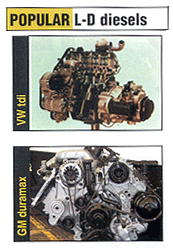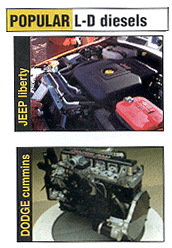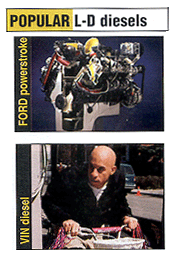Diesel engines are nothing new. The basic design for a compression ignition engine dates back to 1892. Patented by Rudolf Diesel, the original diesel engine was developed to power industrial pumps. Over the years, diesel engines have powered everything from trucks to cars to Humvees and tanks. There have even been a few diesel-powered Indy cars! In Europe where fuel prices are up to four times higher than in the U.S., diesel engines power more than half of all new cars and light trucks. In France, Belgium, Austria, Luxembourg and Spain, 60% of new passenger vehicles are diesel. Yet in the U.S., diesel engines currently power less than 4% of the light vehicle market. The only applications where diesels dominate here are in big trucks, farm machinery and industrial engines. More than 91% of all heavy-duty trucks, 95% of transit buses and emergency vehicles, 60% of all school buses and 67% of all farm machinery are currently diesel-powered in the U.S.
 HOOKING Up
HOOKING Up
Light-duty diesels have long been a popular option in pickup trucks in the U.S. for their stump-pulling power and good fuel economy. Current trucks with diesel options include Chevy Silverado, GMC Sierra, Dodge Ram, Ford E-Series, F-Series and Excursion. Theres even limited productions of diesel-powered Jeep Libertys available.
As for passenger cars, currently there are no diesel-powered domestic models. Volkswagen and Mercedes-Benz are currently the only manufacturers who are offering diesel options. VW offers diesels in its Passat, Golf, Jetta and Beetle cars, and the Touraeg sport utility vehicle. Mercedes recently added a diesel option for its E 320 Class luxury sedans, with more models to come.
Diesel differences
Compared to gasoline engines, diesels have a number of important advantages. One is fuel economy. Diesel engines are unthrottled so pumping losses are reduced. This improves breathing efficiency for more fuel-efficient operation. Diesel engines also run much leaner air/fuel ratios than their gasoline counterparts, and have much higher compression ratios, which improves thermal efficiency and helps squeeze up to 30% more power out of every drop of fuel. Diesel engines have no ignition system, so there are no spark plugs, plug wires or distributor to cause problems. The fuel is ignited by the heat of compression and is controlled by injector timing. For cold starting, diesels use a glow plug system that creates heat in the combustion chamber until the engine is running and generating its own heat.
The injection system that delivers fuel to a diesel engine operates at much higher pressure than a gasoline engine as much as 17,400 psi for traditional pump, line and injectors, and up to 23,500 psi for common rail systems compared to 35 to 90 psi for most gasoline EFI systems. The fuel is also sprayed directly into the combustion chamber rather than into the intake port.
Most light-duty diesels use an engine-driven inline pump to distribute fuel under high pressure to each of the injectors. The injectors are mechanical and have spring-loaded poppet valves instead of solenoids, so they pop open and spray fuel when line pressure exceeds a certain limit (typically 4,500 psi). Electronic controls on late-model injection pumps regulate injection timing, fuel mixture and idle speed. On older applications, these required mechanical adjustments.
A somewhat different approach is used with Bosch common rail diesel injection systems, which are now in production on some of the newest diesel engines in Europe, plus late-model Duramax engines used by GM and Dodge Rams equipped with the Cummins 5.9L. A high-pressure supply pump delivers fuel to a common fuel rail that supplies all the injectors. The opening and timing of the injectors is controlled by individual solenoids on each injector rather than the injection pump. This allows more flexibility and control over the combustion process for improved fuel economy and emissions.
 When the glow is gone
When the glow is gone
If slow cranking is not the problem, hard starting may be due to one or more glow plugs that arent working. One or two bad glow plugs on a V8 engine may not cause a noticeable starting problem during warm weather, but they will when temperatures drop. If an engine is hard to start during hot weather, but cranks and runs normally after it has warmed up, its likely the glow plug system is not working at all.
Inside each glow plug is a high resistance heating coil. The plugs are designed to handle high current loads (up to 300 amps in some applications) so they will heat up quickly. Within four seconds or less, most glow plugs on newer vehicles will reach a surface temperature of 850 C (1,562 F), though on some older applications the wait period can be 30 to 60 seconds or more. Glow plugs in a fast-start system take only about four seconds to reach 1,000 C (1,830 F). The higher operating temperature combined with a faster heating rate means less waiting and less cranking to start the engine.
Normally, current to the glow plugs is cut off when the ignition is turned to the start position. Since the late 1990s, glow plugs have been designed to remain operating while the engine is cranking and for a short period of time afterward to keep the fire lit while the engine warms up. The after glow period following startup may range from 20 seconds to a couple of minutes depending on the application, ambient air temperature and engine temperature. When the glow plugs are no longer needed, the system control module or thermo time switch de-energizes the glow plug relay, cutting off power to the glow plugs so they can cool down.
 Checking out the glow
Checking out the glow
To see if the glow plug module is providing power to the glow plugs, use a voltmeter to check each plug for the specified voltage when the ignition key is turned on. No voltage? Check the glow plug control module connections, ground and wiring harness.
The glow plugs themselves can be checked by measuring their resistance or continuity. Excessive resistance or a lack of continuity would tell you the plug is bad.
Glow plugs can burn out if they get too hot. Overheating can occur if the system controller or relay fails to shut down after the normal engine startup period. A glow plug relay that is stuck on will also run down the battery, so thats another clue to look for if you suspect this kind of problem.
If one or more glow plugs have burned out, the system controller (or thermo time switch) and relay should be checked to make sure they are working properly otherwise the replacement glow plugs will suffer the same fate. If all the glow plugs are burned on the end, youd better check the injection timing because it is probably overadvanced or the system controller is stuck in the On position.
Current caution!
On most Ford and General Motors light-duty trucks, the glow plug system operates on 6 volts rather than 12 volts. This allows the plugs to handle higher current loads so they will warm up more quickly. But it also requires a step-down resistor in the system controller to reduce the voltage to the glow plugs.
Whats important to know here is that too much voltage can overheat and burn a 6V glow plug. If somebody attempts to test a 6V glow plug system in a truck by feeding it a full 12V from the battery, theyll probably damage the plugs. The same can happen if 12V glow plugs are accidentally installed in a truck application that requires 6V glow plugs. On most passenger cars applications, the glow plugs operate at 12V so glow plugs can be safely tested by using full battery voltage.
Fouled fuel
Unlike gasoline, diesel fuel thickens when temperatures drop. The cloud point at which wax starts to form in ordinary summer grade #2 diesel fuel ranges from 10 to 40. So if a diesel-powered vehicle contains the wrong grade of fuel when temperatures drop, wax crystals may form in the water/fuel separator causing a blockage (some vehicles have fuel heaters to prevent this, but others do not).
Water in the fuel is another problem that can cause starting and performance problems. Condensation that forms during cold weather is the primary source of contamination. Water that gets into the fuel tank usually settles to the bottom because water and oil dont mix. The water is sucked into the fuel line and goes to the filter or water/fuel separator (if the vehicle has one). Here it can freeze causing a blockage that stops the flow of fuel to the engine. So if you find the filter or separator is iced up, the fuel tank needs to be drained to get rid of the water.
Diesel fuel can also become contaminated with microbes that form slime and gum up the fuel lines, filter, injection pump and injectors. Contaminated fuel often has a rotten egg odor, and leaves a black or green coating on the inside of fuel system components. To get rid of the unwanted organisms, the fuel tank needs to be drained, cleaned and treated with a dose of biocide to kill the bugs.
To keep the diesel fuel system clean and free flowing, recommend the regular use of a good diesel fuel additive.
Injection problems
To start and run properly, injector timing has to be accurate. On some diesel engines, injection timing is set by rotating the pump. So you can check to see if the pumps timing marks are properly aligned with the reference marks on the engine.
On others, static pump timing is set with an offset keyway on the pump shaft. The keyway has a three-digit code that is matched to the injection pump. Twenty-one different keyway calibrations are available, which means if someone replaced the pump and installed the wrong keyway (or installed the right keyway backwards), injection timing will be off.
Summing up
Time will tell if the current momentum towards greater use of diesels in light vehicles will continue, and how the EPA diesel fuel and emission regulations will impact the market. It all depends on world oil prices, pump prices for gasoline and diesel, and consumer acceptance of clean diesel technology.
For more info on diesel, visit: www.dieselforum.org.


